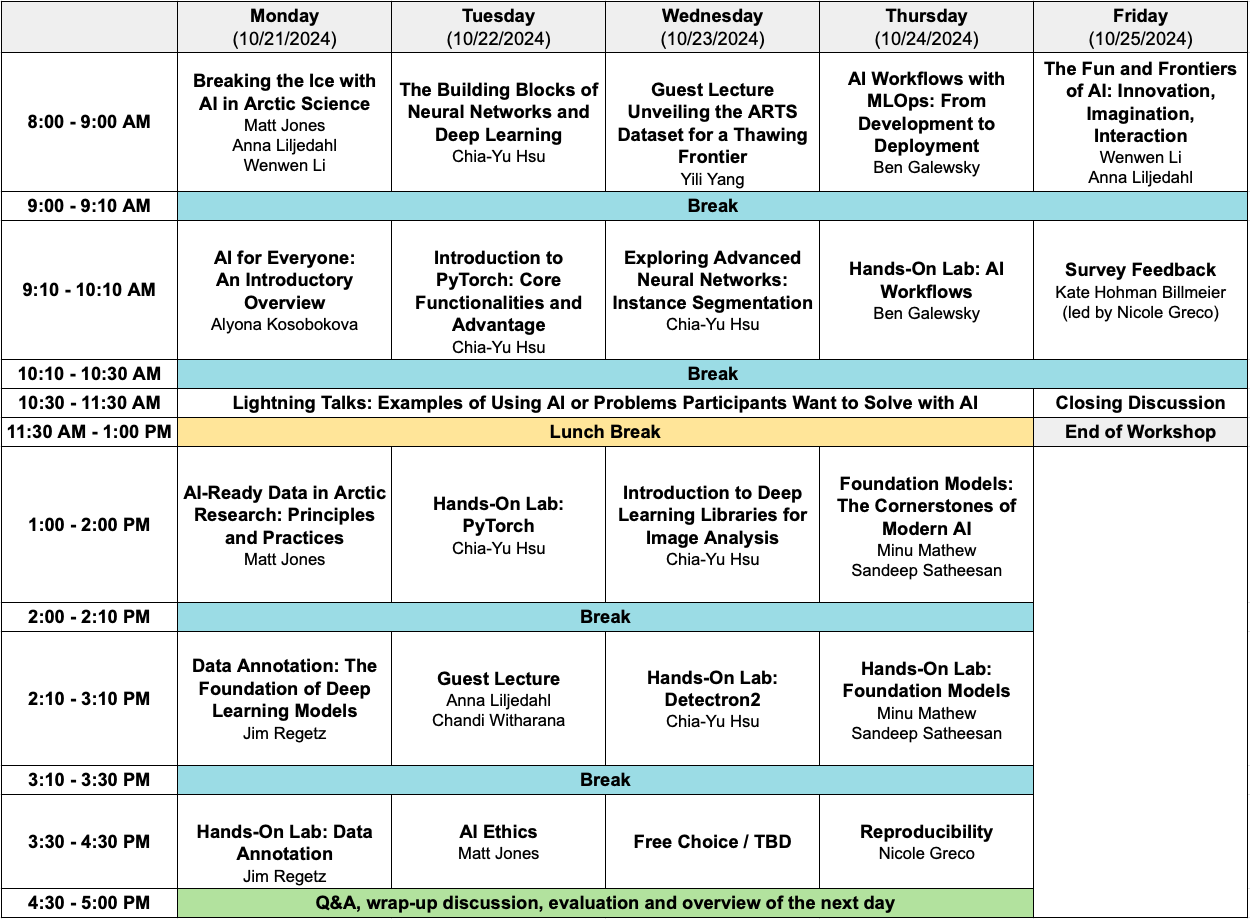Cyber2A: AI for Arctic Research
Course Overview

AI for Arctic Research represents an introduction to Artificial Intelligence (AI) techniques produced by the Cyber2A project, an innovative training program to empower the Arctic science community with advanced AI-driven data analytics and cyberinfrastructure (CI) skills to tackle the pressing challenges facing the Arctic and thus our planet. Today, Artificial Intelligence has become one of the most powerful tools to analyze Arctic big data and enable new ways of data-driven discovery. However, training on these emerging topics is often missing in current undergraduate and graduate curricula, particularly for active Arctic researchers. This project aims to fill this skills gap in order to foster the growth of an Arctic science workforce with strong data science skills through a series of complementary and mutually reinforcing training activities.
The week-long course is designed with a modular curriculum, where each module can be incorporated into learning activities across Universities and other organizations. The curriculum is free to be re-used, licensed under a CC-BY Attribution license and covers 5 main topical areas:
- Introduction to AI and Arctic Science
- AI Fundamentals and Techniques
- Advanced AI Workflows and Models
- Workflows and Foundation Models
- AI Frontiers
The sections presented here fit into a one-week workshop as follows, but the modules can be also used individually:
Code of Conduct
Please note that by participating in this activity you agree to abide by the NCEAS Code of Conduct.
Session Structure and Content
The course has been designed with several guiding principals in mind.
Balance Theory and Hands-On Work: Spend about one-third of the time on theory and the other two-thirds on hands-on activities.
Build Gradually: Start with the basics and build up gradually. Expand both the theory and hands-on tasks as you go along.
Choose Your Tools: You can use either Jupyter Notebook or VSCode for the hands-on parts of your session. Choose whichever one you’re more comfortable with.
Open Data Licensing: Use open data for examples that can be ethically shared and re-used, both within the workshop and when the course materials are used and incorporated into other courses.
Offer Support: Make sure participants know how to ask for help if they get stuck. Regularly ask participants if they’re keeping up and adjust the pace if needed.
Extra Resources: Provide additional materials like readings or videos for participants who want to learn more.
About this book
Citation:
Wenwen Li, Anna Liljedahl, Matthew B. Jones, Chia-Yu Hsu, Alyona Kosobokova, Jim Regetz, Chandi Witharana, Yili Yang, Ben Galewsky, Minu Mathew, Sandeep Puthanveetil Satheesan, Nicole Greco, Kenton McHenry, Carmen Galaz García, Kate Holman Billmeier. 2024. AI for Arctic Research. Arctic Data Center. doi:10.18739/A2222R77V
The materials in this book are licensed for reuse, and are available from the cyber2a-course github repository. The book is written in Quarto, a cross platform markdown-based platform for writing books and technical materials that works with Python, R, and other languages.
Getting Started: You can find a guide to getting started with Quarto, including editing and previewing content locally with various tools, here.
Quarto Guide: You can find a comprehensive guide to Quarto here.
Format: You can choose to write your content in either Jupyter Notebook (
.ipynb) or Markdown files (.qmd). Quarto can render both formats. And both formats can be easily included in other teaching materials.Embed Notebooks: If you choose to write your content in Markdown but have a separate Jupyter Notebook for the hands-on part, you can embed the notebook. Follow the guide here to learn how to do this.
Acknowledgements
These course materials were developed with funding for Cyber2A from the National Science Foundation under award # 2230034 to W. Li and M. Jones and award # 2230035 to A. Liljedahl and K. McHenry
License
Cyber2A: AI for Arctic Research is licensed under CC BY 4.0
